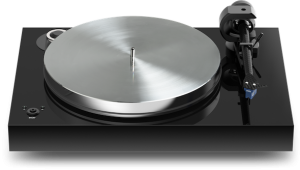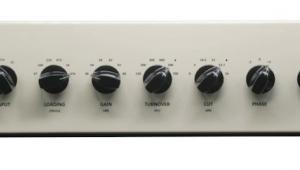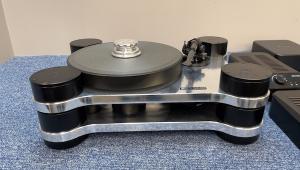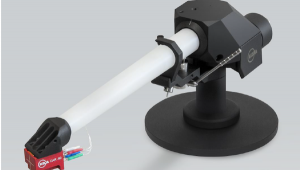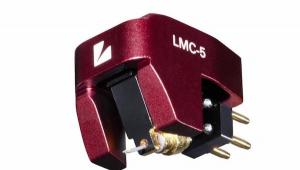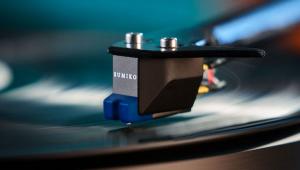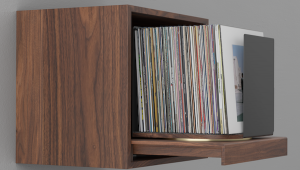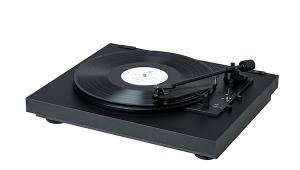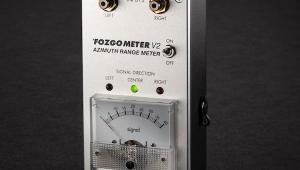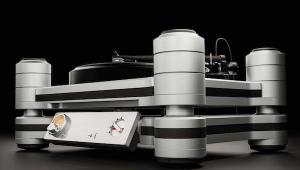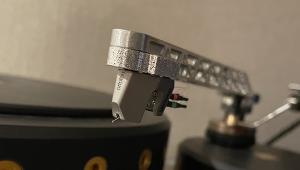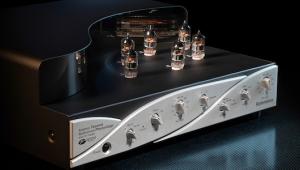I just love shows. If I couldn't be there, I am so happy that you were!
Capital Audiofest Show Report, Part 1
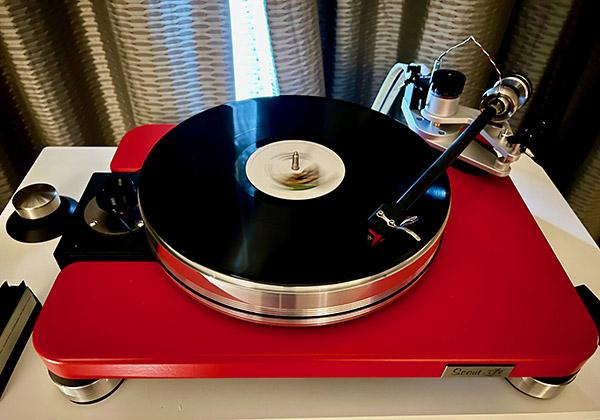
It was a fine time to be in the Washington, D.C. metro area for the most recent Capital Audiofest (CAF) that was held November 10 to 12, 2023, at the Twinbrook Hilton in Rockville, Maryland. A growing show, CAF has expanded to encompass a reported 114 exhibit rooms across more than four floors in addition to conference rooms throughout the hotel.
This year, CAF organizer Gary Gill told me the show drew approximately 4,200 attendees — audiophiles and music lovers from near and far — making it CAF’s biggest show yet. Attendance was strong on Friday, which can tend to be a lighter day for shows like these. Saturday was solid (iffy or inclement weather often helps the cause) with somewhat slower show traffic reported on Sunday.
Here in Part 1 of my two-part CAF 2023 show report are some analog-related highlights, including a couple of new turntable introductions and a few other surprises.
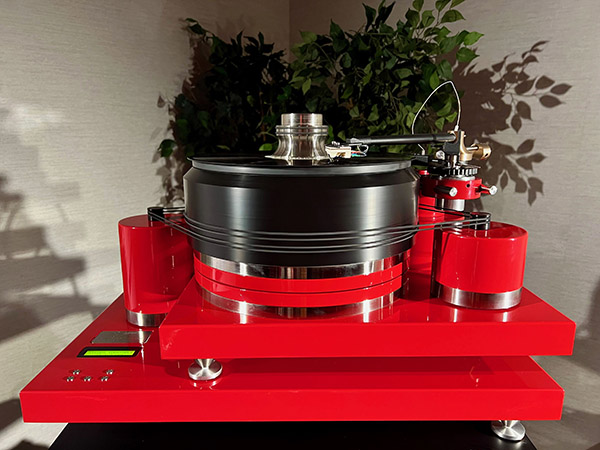
J. SIKORA
A shiny, new red J. Sikora Standard Max Line Special Edition turntable ($23,000) debuted in the Democracy Room that was run by Jeff Fox of D.C.-area dealer Command Performance AV of Falls Church, Virginia. (Fox also operates a distribution company called Notable Audio Products.) The Max was shown with a KV Max 12in tonearm ($14,500) made of Kevlar. At the end of the Aidas Archer arm was an Aidas Mammoth Gold Cartridge ($8,650) — and it is indeed aptly named, since the cartridge body is made of actual mammoth tusk. Aidas is a Lithuanian company known for their use of exotic materials such as stone, coral, and jade. The namesake “Gold” refers to the wire material inside (whereas other versions deploy silver or copper wire). A Doshi Audio Evolution phono stage ($20,995), a tubed beauty, amplified the MC cart’s output.
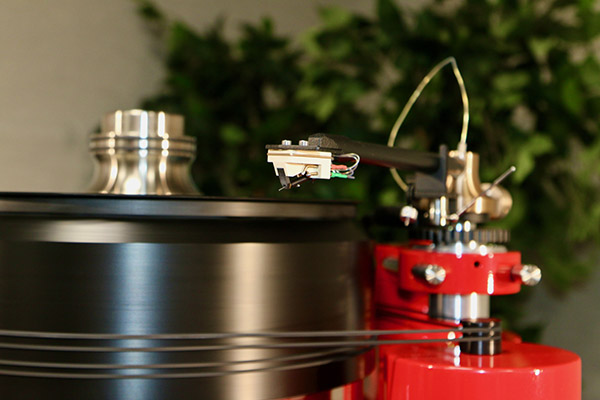
If the J. Sikora turntable’s flashy sportscar-style red finish isn’t your thing, you can choose from a huge palette of color options. Fox also told me this J. Sikora turntable usually comes with a small linear AC power supply, but here the ’table was demo’ed with a matching red upgraded Reference Special Edition power supply ($6,850 extra) that contains three levels of filtering “to stabilize the power,” according to Fox. Its front-panel displays show incoming current and the 24V output levels.
Sharing the stage with the J. Sikora turntable was a new Gryphon Diablo 333 integrated amp ($24,999) that was being shown for the first time in the States. Gryphon’s Director of Sales and Marketing Anthony Chiarella, who also runs the Specialty Sound & Vision rep firm and can be seen at left in the photo below, with Jeff Fox on the right — was on-hand describing the big amp. It’s rated at 333W per channel into 8ohms, doubling into 666Wpc into 4ohms — an output figure that Chiarella jovially joked about with an, er, “evil” reference. The Diablo 333 powered a pair of Magico S3 2023 speakers ($45,500).
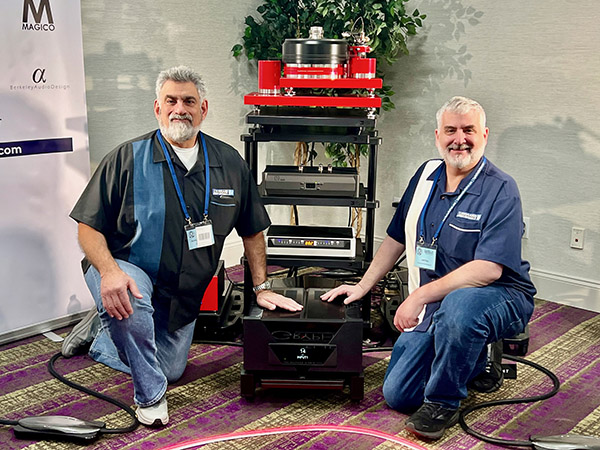
I also happened to drop by the Democracy Room just before Mathew Cravens, the fellow behind East-West Jazz Connection record collectibles, gave a brief, casual talk. He described how he makes occasional quick-turnaround trips to Japan in search of prime Japanese jazz pressings: He’ll fly out on a Thursday and return on a Sunday with a wheeled suitcase and a carry-on roller bag filled with rare LPs — about 114 to 125 per trip — to collect and/or sell stateside (and presumably beyond). He brought some of these LPs to CAF to sell, and spun a Japanese pressing of Grant Green’s 1980 Blue Note release Remembering on that new J. Sikora ’table. The sound was smooth and well-controlled, yet lively. And clean.
In related Room 307, another J. Sikora ’table was on demo: the J. Sikora Initial Max turntable ($14,745) with another Kevlar arm — well, two J. Sikora KV12 12in tonearms ($8,995), one with a Lyra Etna SL Lambda SL cartridge ($9,995) on a black finished tonearm, the other in Kevlar’s natural gold-colored finish with a Lyra Delos cartridge ($2,000). The four-belt-driven turntable comes with two tonearm towers and an external linear power supply. The bearing components include an inverted ceramic ball, and its platter is made of Delrin. Other materials used in the ’table’s construction are aluminum, Inox (a sort of European stainless steel), and iron.
Fox explained that a father-and-son team were behind J. Sikora’s designs, and the father worked for Sikorsky and had a materials-expertise background in metals. As in the other room, a Doshi Audio Evolution phono stage amplified the cart’s signal. Speakers here were the Joseph Audio Perspective2 Graphene ($16,999/pr). Attendees in the crowded room murmured appreciatively after soaking up a couple of cuts from an audiophile staple — the new Analogue Productions’ 45rpm 2LP UHQR edition of Steely Dan’s Aja.
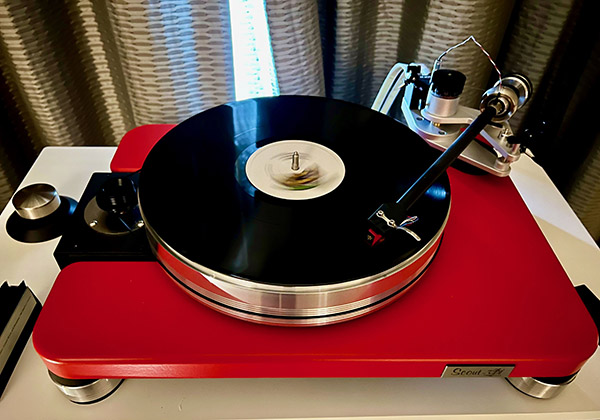
VPI
There was at least one other crimson-hued turntable at this year’s CAF — namely, the deep red plinth of a belt-driven VPI Scout turntable ($3,300; including tonearm, excluding cartridge) fitted with Shyla cartridge that captured my attention in Room 825, along with PureAudioProject Trio15 open-baffle loudspeakers with Coax10 coaxial drivers ($8,650/pr) and Silversmith Fidelium internal wiring ($1,850) and speaker cables ($1,195). A Pass Labs SP-17 phono preamp and INT-25 integrated amp supplied amplification.
VPI was all over CAF 2023. In the lobby, I spied a special-edition VPI turntable displayed in an enclosed case. Bearing the U.S. Presidential Seal on its platter mat, it drew my attention. Closer inspection revealed a plaque stating the turntable had been a gift presented by President Joe Biden to the Honorable Anthony Albanese, Prime Minister of Australia, on occasion of his Official Visit on October 24, 2023.
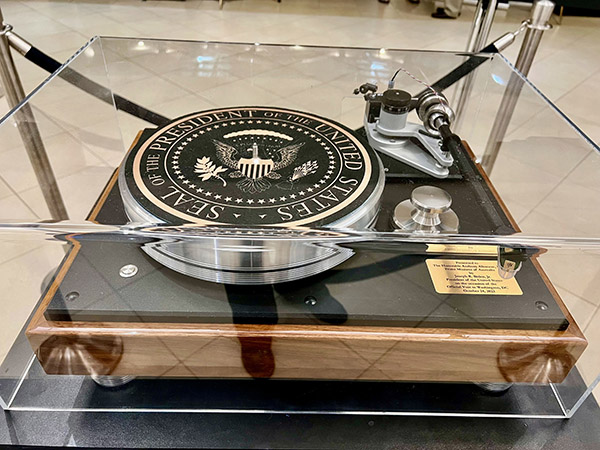
I’m ashamed to say that, somehow, I missed visiting the main VPI room at CAF — and what surely was a lively Casino Night event on Saturday. Next time, I promise!
DALBY AUDIO DESIGN
In Room 327, music lover, drummer, and dealer Jeffrey Catalano of NYC’s High Water Sound — who also imports high-end equipment from companies such as TW-Acustic, Cessaro Horn Acoustics, and Dalby Audio Design — demo’ed a noteworthy system of artisan audio products. Catalano specializes in niche and esoteric gear too. One sky-is-the-limit example at this show included a Dalby Audio Design bejeweled record weight that resembled a smaller-diameter crown fit for royalty. Its elaborate geometrically elegant design contains titanium, 14-carat gold over brass, Mpingo ebony, etc. The creator is England’s Lee Dalby, a former Porsche engineer and materials expert whose experience includes work with a type of “unobtanium” carbon fiber used in LeMans racecars, for instance.
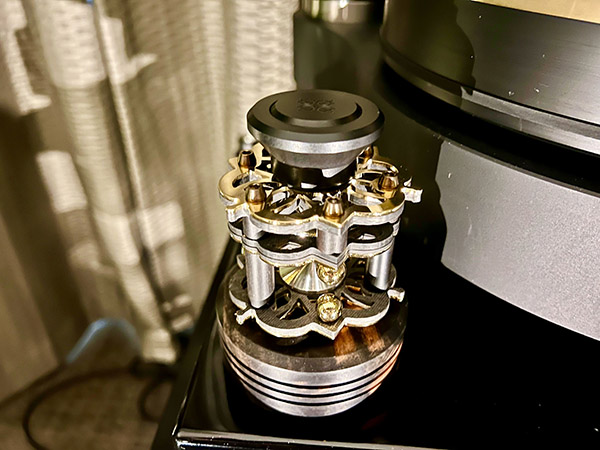
While I was in this room, mastering engineer Dave McNair stopped by with a few lacquers in tow inside a cardboard case. He said he’d been working with a new lathe and wanted to listen on Catalano’s system to check the sound for signs of distortion, especially in the treble on a couple of delicate, oversized discs. The system included a TW-Acustic Raven LS-3 Copper turntable with Raven-line tonearms and amplification ahead Cessaro Wagner II horn speakers.
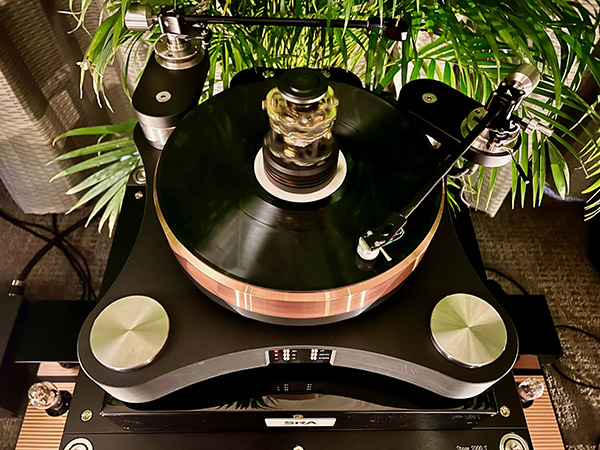
Finally, Catalano himself cued up the Miyajima Infinity mono cartridge on a rare, if imperfect, mono version of Miles Davis’ landmark August 1959 LP, Kind of Blue. Paul Chambers’ bass strings came through beautifully, sounding more believable and more tactile than ever.
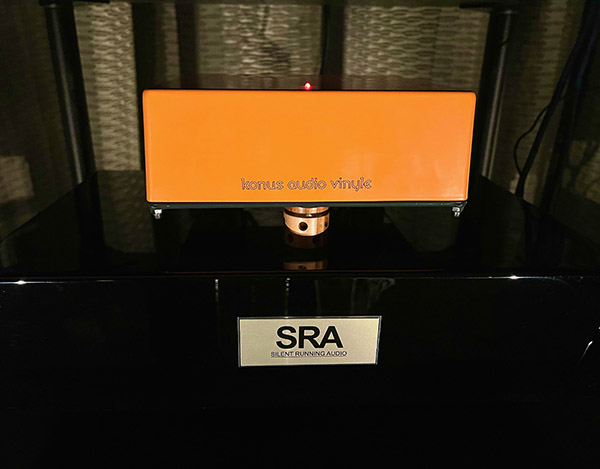
KONUS AUDIO
Some other standout analog components color-wise, sound-wise, and otherwise turned up next door in the Gestalt Audio-hosted Room 325 — Konus Audio amplification products from Bosnia, including one with a compact chassis in an attractive deep orange finish called the Konus Audio Vinyle 3000 phono preamp ($6,500), along with a pair of Konus Robusto 3000 monoblock amps ($7,000) sporting 32W per side and Class AB designs. The Konus Vinyle has one input — RCA unbalanced — and is a transimpedance design for automatic calibration to match compatible cartridges’ gain and loading. “Compatible” meaning to make sure the cartridge you’re pairing it with is suitable — i.e., that it has an internal impedance below 20ohms. That said, I was told 10ohms is a really safe number — as in, the lower, the better.
According to their site, Konus Audio launched their first line of electronics in 2016, following three years of development. The Vinyle amplified the output from a Fuuga cartridge ($10,000) at the end of a TW-Acustic Raven 10.5in tonearm ($6,000) on another TW-Acustic ’table, the Raven GT-2 ($12,000).
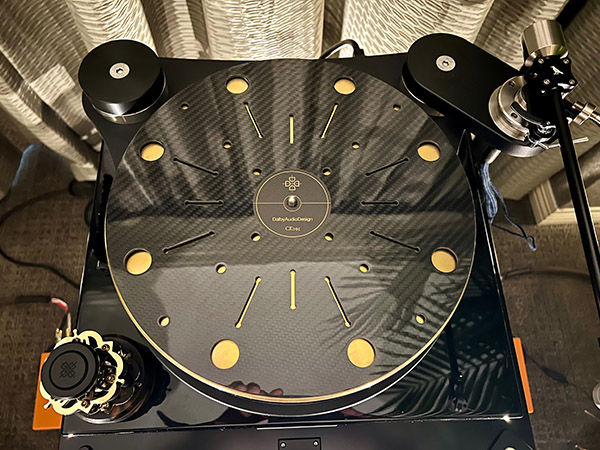
Also shown there were other Dalby Audio Design products including another, slightly different Dalby record weight from the one seen in the High Water system next door that was shown earlier in this story (apparently, each design is unique). On the turntable was a Dalby Audio Design platter mat that featured wood discs — Mpingo ebony — embedded within its carbon fiber, with more of the pieces exposed on one side than the other (for different sonic effects, natch).
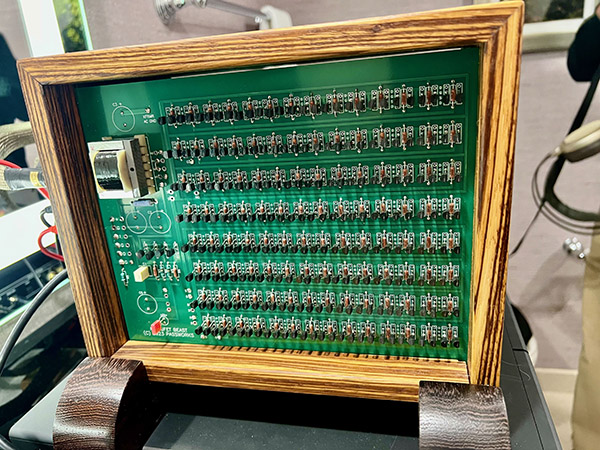
PASS LABS
Elsewhere at the show, Pass Labs provided some lucky listeners a surprise sneak preview. Me, I had actually received a tip about it from a young mastering engineer and another guy who works for a different amplification maker. They’d told me the demo room was on the third floor, before adding I should also ask to check out what was in the bathroom — which, for obvious reasons, sounded sketchy. I sought additional clarification, and was reassured it was fine — and well worth a visit.
And it was. Sitting on the sink’s countertop — just beside the basin and a full-sized computer running J River — was a quasi-finished chassis’ framework containing a stereo amp that (as a temporary workaround, I was told) had its transformers and power supply in a separate chassis, all tethered to a pair of Stax 007 Mk1 headphones. The USB-connected DAC/preamp was an EMM Labs DV2, Meitner Design, with lossless volume control.
I just had time to listen to a couple of tracks off that computer — Afro-Cuban All Stars’ rendition of “Chán Chán” from Live in Japan, Disc 1, and a FLAC file of “Sambia” from Pancho Sanchez’s Latin Spirits album. The sense of air and open space between musicians felt very natural, as did brass tones. I was struck by the textural details on percussion and the overall immediacy — the apparent ease of fine detail retrieval. I was told the “secret” amp was a pre-production prototype with “pretty finalized” circuitry of Pass’ Mini JFET Beast amp with “an overpowering 5 Watts, but we’ll make do. . .”
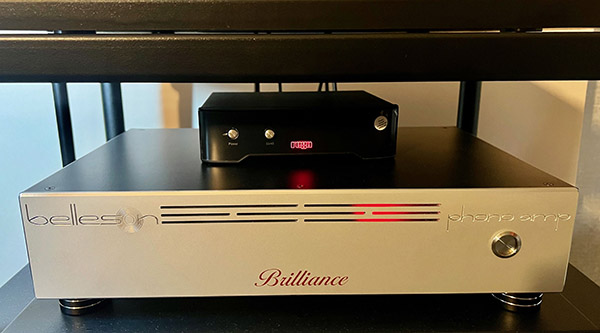
BELLESON
Belleson is a new name for making hi-fi equipment, but they’ve been in the business as a manufacturer and supplier of parts to the industry since 2010. Based in South Carolina, the company manufactures their own op-amps, Superpower voltage regulators, and other components. Belleson Operations Manager Christina Lowe told me they supply their proprietary voltage regulators to other hi-fi companies, including Vinnie Rossi and Linear Tube Audio (LTA).
At CAF 2023, Belleson introduced their first full-blown hi-fi offering (one not offered by their customers, against whom they have a policy not to compete) — the Belleson Brilliance Phono Amp phono preamp ($8,500) with their matching “Wi-Fi HiFi browser-based” remote control. The unit is also equipped with a detachable Wi-Fi antenna.
The Belleson Brilliance Phono Amp uses 16 custom discrete op amps and their patented “Double Superpower” voltage regulators in this fully DC-coupled design that is said to boast “the quietest noise floor you’ve never heard.” The Brilliance Phono Amp comes with RCA phono inputs, switchable between balanced and unbalanced, along with a ground terminal. Inputs include two stereo pairs — a balanced XLR or RCA (though only one can be deployed at a time), and a second RCA pair.
There are low and high gain settings ranging from 30 to 50dB (more typical for moving magnet [MM] cartridges) and 50 to 70dB (more likely for moving coil [MC] cartridges). Resistive and capacitive loading is also adjustable. There are eight user-selectable impedance settings — from 47kohms for MM, plus seven for MC from 20 to 700ohms — to adjust MC cart loading. Users can also adjust capacitance for MM carts across 16 settings. The software controller has a way to specify which input pair has which setting so you can adjust the settings via the remote control, then save, or “lock,” them.
Output-wise, there’s a single pair of RCA outputs, but Lowe told me they have plans for XLR outs as well. The Belleson Brilliance Phono Amp, which will begin shipping in early 2024, was shown in a setup with a Dr. Feickert Volare turntable with Origin Live tonearm and an Ortofon 2M Black cartridge ($4,800, as shown at the top pf this Belleson section).
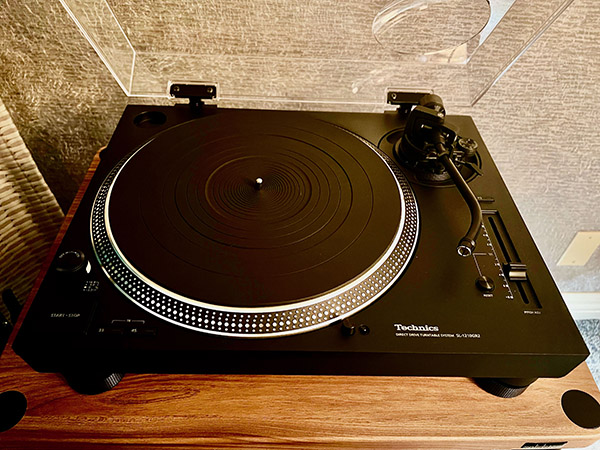
TECHNICS
On passive display in a sixth-floor suite was a new introduction from Technics we had previewed on AP back in late-September — the Technics SL-1210GR2 turntable, a direct-drive model that recently received upgrades as described by Technics Business Development Manager Bill Voss. In an active demo, there was also the SL-1200G turntable, the one from which the SL-1210GR2 had trickled down.
Direct-drive turntable proponents cite advantages of quick starting times and consistency, ease of use, and not having to replace belts, idlers, rims, and so on. Here’s some further background: Technics pioneered direct-drive turntables — where the platter is driven directly, and at relatively low speed — starting in 1970, for both broadcast and audiophile use. In 1979, the company came out with quartz-lock technology for their second generation of ’tables. Next came the coreless direct-drive system, known as generation three. The idea was to remove the iron core from the motor, Voss explained, to further minimize micro-vibrations — and to improve performance to appeal more to audiophile interests.
The current, fourth gen of direct drives use digital technology inside — now deploying delta sigma technology — which is said to control and increase rotational accuracy and remove more micro-vibrations from the coreless motor system.
The SL-1200G, the coreless-drive G model featured at CAF in an active demo system, has a heavy motor with two rotors with circular magnets on both sides and with coils in the center. It contains a three-layer platter of brass, aluminum, and rubber compound on the bottom to prevent ringing. It has a four-layer plinth, including an aluminum top layer, aluminum die-cast chassis and bulk mode compound, plus heavy zinc footers with silicone to absorb vibration. Finally, it uses a magnesium tonearm.
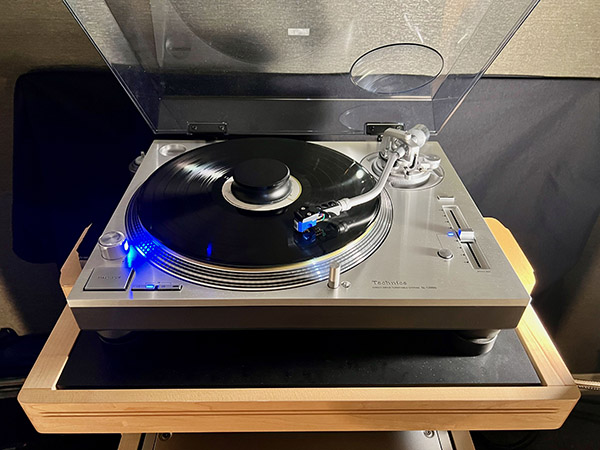
The new SL-1210GR2 turntable ($2,200) introduced at CAF is an updated version of the GR turntable that was created to offer a more affordable version of the G model shown above, the SL-1200G ($4,300) — and at about half the price — but with a few compromises, as Voss explained. Differences between the less-pricey GR models and the G include an aluminum tonearm (instead of magnesium) and a two-layer (instead of four-layer) plinth with metal footers instead of zinc ones. Like the prior GR model, instead of deploying a dual-rotor drive found in the pricier SL-1200G, the new SL-1210GR2 turntable uses a single-rotor, surface-facing, coreless direct-drive motor.
Like the upper G models and prior GR edition, the GR2’s mechanisms also deploy digital technology to control speed accuracy, with the new GR2 incorporating the latest delta sigma drive technology, Voss said.
The SL-1210GR2 also sports new styling details as an upgrade over the prior GR: silver finish on the tonearm, power button, and 45rpm adapter. The SL-1210GR2 comes with interchangeable RCA cables, AC cords, and tonearm and headshell, but without a cartridge.
At the time I visited, the active demo setup had one such G model in place — an SL-1200G turntable ($4,300) fitted with a Hana Umami Blue cartridge ($2,500) and connected to a Technics SU-R1000 integrated amp ($10,000) with phono preamp and EQ settings and cartridge optimizer that enables user-customizable calibration for various cartridges, as well as powering Sonus faber Sonetto V speakers ($5,000/pr).
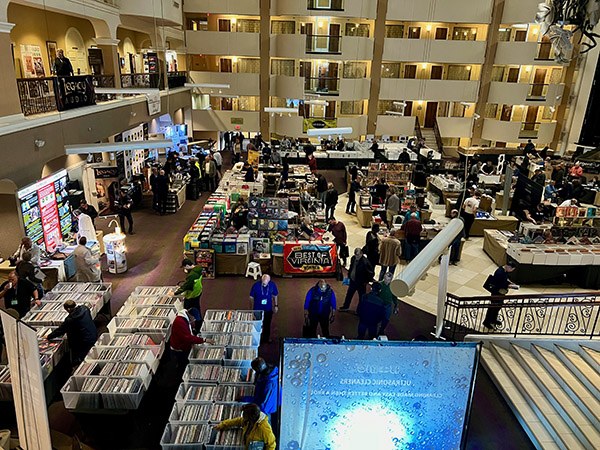
TRANSROTOR & VAC
In the hotel’s central atrium, a score or more of record dealers were selling their vinyl wares, alongside myriad accessories, and even some CDs. Right off the main atrium was a highly visible — unmissable, even — large demo room with a high-end system presented by The Audio Company. The elaborate system featured a full stack from VAC (Valve Amplification Company) with Von Schweikert Endeavor Special Edition speakers ($27,000/pr).
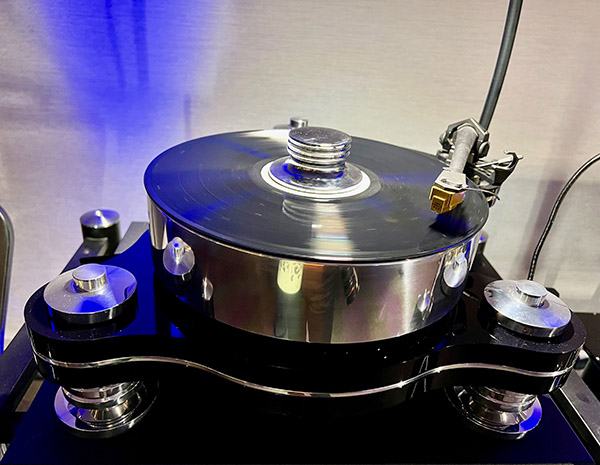
Sources included a suite of Esoteric and Aurender products. The analog setup included a Transrotor Rondino turntable (as seen above; $23,200, without arm) with an Air Tight PC-1 Supreme MC cartridge ($11,000) mounted on its Transrotor TR5003 tonearm with signal going to a VAC Statement phono preamp ($80,000) and Line preamp ($80,000), and four Signature 202iQ power amps ($22,000 each) making their world premiere at CAF.
Sound was room-filling and highly musical. A listen to part of Yo-Yo Ma’s rendition of Ennio Morricone’s Sergio Leone Suite: Ecstasy of Gold (from Morricone’s 1966 The Good, the Bad, and the Ugly score) soared as it should, full-bodied and rich in textural details on cello and with a strong sense of scale.
It was near the end of the show, and a gentleman handed over what I expected to be an audiophile classic, but no — instead, it was a copy of Slowdive’s everything is alive, the British band’s latest LP on Dead Oceans. They played Side 1, Track 2, a song titled (and also in all-lowercase) “prayer remembered,” an atmospheric, almost hypnotic track with swirling guitar echoes and effects and crisp percussion that sounded, well, alive — or almost live, present in the room. To my ears, it sounded like these shoegazers from that alt-rock genre’s late 1980s/early 1990s origins have returned in fine form.
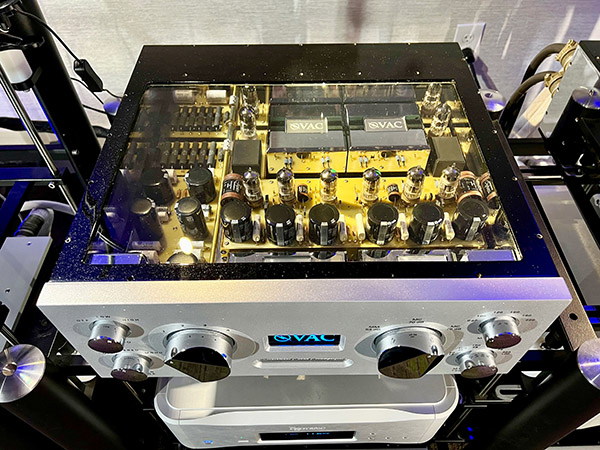
Author bio: Julie Mullins, a lifelong music lover and audiophile by osmosis who grew up listening to her father’s hi-fi gear, is also a contributing editor and reviewer on our sister site, Stereophile, for whom she also writes the monthly Re-Tales column. A former fulltime staffer at Cincinnati’s long-running alt-weekly CityBeat, she hosts a weekly radio show on WAIF called On the Pulse.
Part 2 of Julie’s CAF show report can be read here, If you’d like to see even more of our CAF coverage, check out Ken Micallef’s turntable-centric video report here.

- Log in or register to post comments



